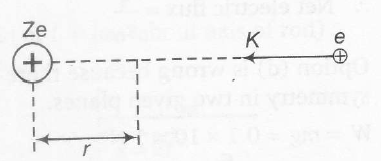Answer:
Option C
Explanation:

r= closet distance =10fm
from energy conservation , we have
$K_{i}+U_{i}=K_{f}+U_{f}$
or $K+0=0+ \frac{1}{4\pi \epsilon_{0}}.\frac{q_{1}q_{2}}{r}$
$K= \frac{1}{4\pi \epsilon_{0}}.\frac{(120e)(e)}{r}$.........(i)
de-Broglie wavelength
$\lambda=\frac{h}{\sqrt{2Km}}$...........(ii)
Substituting the given values in above two equations, we get
$\lambda=7 \times 10^{-15}m=7 fm$